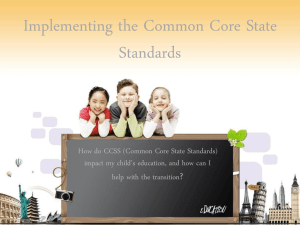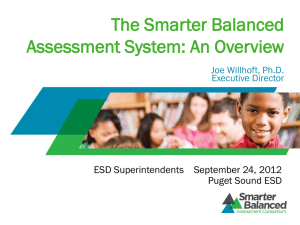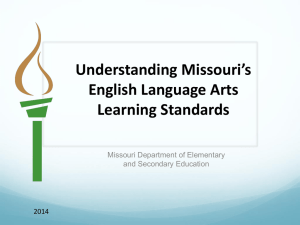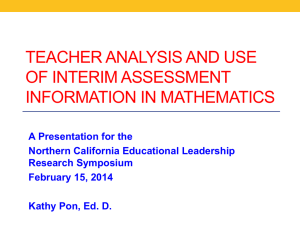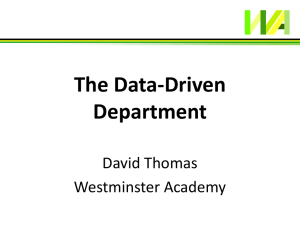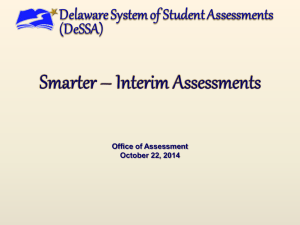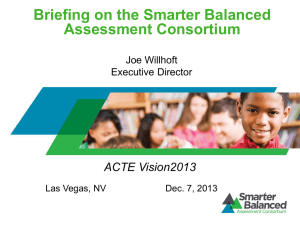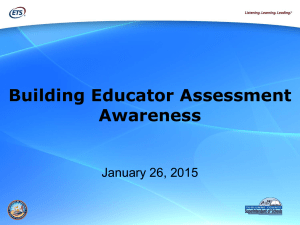Missouri Assessment Program Transition
advertisement
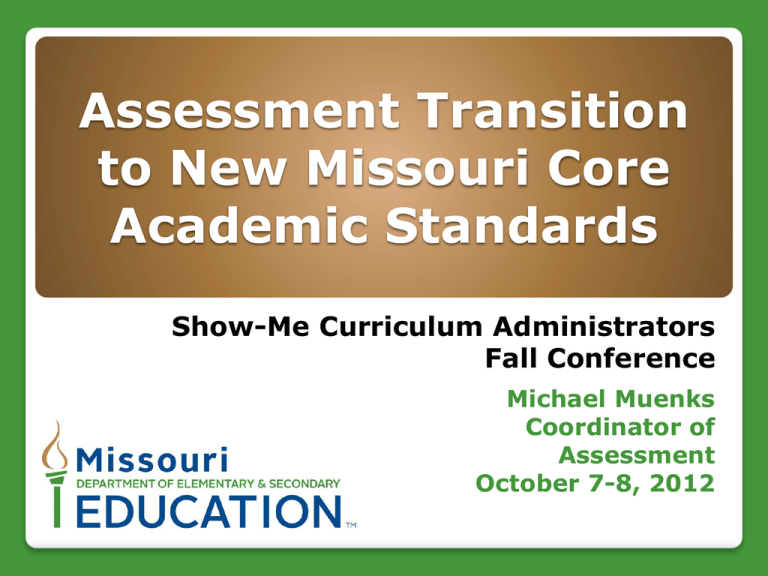
Assessment Transition to New Missouri Core Academic Standards Show-Me Curriculum Administrators Fall Conference Michael Muenks Coordinator of Assessment October 7-8, 2012 Setting the Stage Our goals: 1. Establish baseline knowledge for the standards transition. 2. Share what the Department knows about the future of assessment in Missouri. 2 Transitions 2nd Cycle of MSIP 3rd Cycle of MSIP 4th Cycle of MSIP 5th Cycle of MSIP •Missouri Mastery and Achievement Tests (MMAT) Core Competencies and Key Skills •Transition to Show-Me Standards as reflected in the Curriculum Frameworks •Transition from the MMAT to the Missouri Assessment Program’s Grade-Span Assessments •Curriculum Frameworks for most content areas and competencies for Career Education •Grade-Span Assessments •GLEs/CLEs developed over time for most content areas •Moved from Curriculum Frameworks over time to GLEs •Developed CLEs from GLEs and course models •Included Career Education competencies •Grade–Level assessments and End-ofCourse assessments introduced •Developed model curriculum units for mathematics and communication arts •Core Academic Standards •Transition from current communication arts and mathematics GLEs and CLEs to Common Core based grade-level and course content •Career Education Standards •Grade-Level assessments, End-ofCourse assessments, and the introduction of an End-of-High-School College/Career-Ready Assessment •Model curriculum for all content areas. All Missouri content standards are related back to the Show-Me Standards by state statute. What are the Core Academic Standards? Common Core State Standards ELA (communication arts)/MA (mathematics) Next Generation Science Standards Career Education Standards Updated standards for other content areas Health/PE Fine Arts World Languages Guidance and Counseling Social Studies 4 Why the need to update academic standards now? Discussions began among state education chiefs and governors in 2007 and were rooted in reflections on A Nation At Risk. Key motivators were International competitiveness Economic development Governor Nixon committed Missouri to the Common Core State Standards June 26, 2009. 5 Leadership Standards drive curriculum/Curriculum is how and when you teach Common Core State Standards Organization Don’t deconstruct – Look at the whole document Progressions, Math Practices, Text Complexity, Glossaries, Appendices, etc. The focus is fewer items to a greater depth. Professional learning will be a key component Evaluate teacher content knowledge – Are there opportunities? Fidelity of curriculum implementation – Are favorite units that are now inappropriate being abandoned? 6 Missouri’s Transition in ELA and MA 2011-2012 2012-2013 2013-2014 2014-2015 • Development of Model Curriculum units per grade and content area K-12 • Awareness presentations • Implementation of Model Curriculum units K-12 • Regional professional learning focused on deep implementation of CCSS as illustrated by Model Curriculum • Dual reporting of current assessments to both GLEs/CLEs and CCSS • Administer current MAP-A •Continued implementation of Model Curriculum units K-12 •Regional professional learning focused on deep implementation of CCSS as illustrated by Model Curriculum •Dual reporting of current assessments to both GLEs/CLEs and CCSS •Begin the process of updating EOCs to fully assess the CCSS •Administer current MAP-A •Field test Dynamic Learning Maps for Alternate Assessment • Full implementation of Model Curriculum • Continued regional professional learning • Administer Smarter Balance Assessment Consortium (SBAC) assessments • Administer Dynamic Learning Maps Alternate Assessment • Field test EOCs designed to assess the CCSS Race to the Top Assessment Consortia Smarter Balance PARCC (27 states including Missouri) Enhanced Assessment Grant Assessment Consortia for Alternate Assessments and English Language Proficiency Dynamic Learning Maps (13 states including Missouri) NCSC ASSETS (31 states including Missouri) Race to the Top and Enhanced Assessment Grants 8 Comprehensive Assessment System The Smarter Balanced Assessment System English Language Arts/Literacy and Mathematics, Grades 3 – 8 and High School* Last 12 weeks of year** DIGITAL LIBRARY of formative tools, processes and exemplars; released items and tasks; model curriculum units; educator training; professional development tools and resources; scorer training modules; and teacher collaboration tools. INTERIM ASSESSMENT Computer Adaptive Assessment and Performance Tasks INTERIM ASSESSMENT Computer Adaptive Assessment and Performance Tasks Scope, sequence, number, and timing of interim assessments locally determined Optional Interim assessment system — no stakes PERFORMANCE TASKS •ELA / Literacy • Math COMPUTER ADAPTIVE ASSESSMENT ELA/Literacy & Math Re-take option available Summative assessment for accountability * Summative and interim assessments for grades 3 – 8 and 11, with additional supporting assessments for grades 9 and 10. ** Time windows may be adjusted based on results from the research agenda and final implementation decisions. Alternate Assessment System The Dynamic Learning Maps Assessment Consortium (DLM) English Language Arts and Mathematics, Grades 3–8 and High School DIGITAL LIBRARY of learning maps; professional development resources; guidelines for IEP development and student selection for the alternate assessment; instructionally relevant tasks with guidelines for use materials, accommodations, and scaffolding; automated scoring (for most) and diagnostic feedback; and online reporting system. END-OF-YEAR ADAPTIVE ASSESSMENT EMBEDDED TASKS ASSESSMENTS A series of more than 100 items/tasks per year embedded within instruction, each with various forms and scaffolds to allow for customization to student needs. Each task typically requires one to five minutes for completion. Two options for summative assessment** Instructionally embedded tasks used with all DLM students. States may choose to use aggregate data for summative purposes (state decision).* Summative assessment for accountability for those states that choose not to use the embedded tasks for accountability. * Alternate assessment systems are those developed for students with the most significant cognitive disabilities and are based on alternate achievement standards. ** Research will be conducted to review the technical feasibility of using data from the tasks for summative accountability purposes. Developed by The Center for K–12 Assessment & Performance Management at ETS. For detailed information on DLM, go to www.dynamiclearningmaps.org. English Language Assessment System The ASSETS* English Language Proficiency Assessment System English Language Proficiency, Grades K–12 DIGITAL LIBRARY of formative resources based on learning progressions; administration and accommodation manuals; professional development resources and materials; sample test items and tasks; online reporting system. Interim Assessment Interim Assessment ON-DEMAND SCREENER** ANNUAL SUMMATIVE ASSESSMENT The use, number, and timing of interim assessments will be locally determined. Periodic, on-demand interim assessments, as locally determined Summative assessment for accountability *ASSETS stands for Assessment Services Supporting English Learners Through Technology Systems and is a collaborative of the Wisconsin Department of Public Instruction, member states, and World-Class Instructional Design and Assessment (WIDA). **The screener is to be given when a student enters a school or is first identified as potentially needing English learner services. Developed by The Center for K–12 Assessment & Performance Management at ETS. For detailed information on ASSETS, go to http://dpi.wi.gov/oea/assets.html. Assessment Consortia Resources http://www.k12center.org/rsc/pdf/Coming_Together_ April_2012_Final.PDF Report by ETS Descriptions of all consortia Presentation slides and resources available http://www.dese.mo.gov/divimprove/assess/sbac.ht ml Smarter Balance sample assessment items 12 Smarter Balance Three Parts: Interim, Summative and Formative 1. Interim (open anytime) – Take away the mystery of the test at the end of the year! • Pre-test students • This is a non-secure item bank • Teachers can create their own assessment or use provided test templates 13 Smarter Balance Three Parts: Interim, Summative and Formative 2. Summative (Window – 12 weeks in the spring) • Secure Item Bank • Online Computer Adaptive Technology The next question is based on your answer to the current question. Like the Nursing Boards, GRE, etc. Question can be from the previous year or, if you are advanced, from the next year. Everyone will have a different test All types of questions and several sessions SR, CR, PE, TE Grades 3-8, and11 14 Smarter Balance Three Parts: Interim, Summative and Formative 3. Formative (open anytime) • Teacher help center • Scoring rubrics, tools for teaching, videos, tools for student evaluation • Social professional networking, collaboration, pooling resources • Professional development 15 Technology Readiness •All the consortia assessments are technology based. •Completing the technology readiness survey and updating it is very important. Make sure your tech people are completing this and keeping it up to date. Call the Assessment Section if you need technical assistance with the survey. •Keep new technology specifications in mind when making purchases. •Plan for bandwidth upgrades. 16 Missouri Assessment Program Transition Grades 3-8 2012-2013 – Normal testing, except PE and WP are BACK in all content areas! Pilot of Smarter Balance assessments. 2013-2014 – Normal testing, except moving the Communication Arts and Mathematics assessments to align as closely as possible to CAS without changing test design or blueprint. Field test of Smarter Balance assessments. 2014-2015 – Implement Smarter Balance assessments in English/language arts and mathematics. Science assessments remain in place. 17 Missouri Assessment Program Transition EOC 2012-2013 – Normal testing, except PE and WP are BACK in all Algebra I, English II, Biology! 2013-2014 – Normal testing 2014-2015 – Normal testing with a field test of CCSS items in all mathematics and English language arts assessments. 18 Missouri Assessment Program Transition MAP-A 2012-2013 – Normal testing 2013-2014 – Normal testing with field test of Dynamic Learning Maps assessment 2014-2015 – New assessments in English language arts and mathematics. Science assessments remain in place. 19 Missouri Assessment Program Transition English language proficiency 2012-2013 – Normal testing using ACCESS for ELLs 2013-2014 – Normal testing using ACCESS for ELLs with field test of ASSETS assessment 2014-2015 – New ASSETS assessment for testing English language proficiency 20 “No more banking of scores” How will this affect you? Watch/listen to the webinar Read the FAQs Talk to your assessment people NCLB Waiver 21 Help us communicate with you! Core Data Screens •This is how the Assessment Section contacts your district with important information. •We recommend not using the superintendent for everything. •Make sure you can receive e-mail from DESE. •Read the DESE e-mails. •Get the information to the correct people. •Many of e-mails are time sensitive. Web-based trainings and meetings will commence in September. Watch for information! 22 Contact Us dese.mo.gov Email: assessment@dese.mo.gov Phone: 573-751-3545 Questions?
